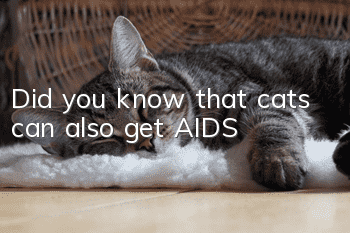Did you know that cats can also get AIDS?

Pets get sick just like people do, such as colds, heatstroke, fever, etc., but did you know that cats can also get AIDS? After cats are infected with feline AIDS, they will develop symptoms similar to human AIDS and immune deficiency. However, feline HIV cannot be transmitted to humans.
1. Introduction to Feline AIDS
Feline HIV is a disease caused by infection with the virus "lentivrus" and is generally only transmitted between stray cats through bites. The infection mechanism is similar to that of human HIV in that it destroys the immune system. But feline AIDS cannot be transmitted to humans.
2. Symptoms of Feline AIDS
Symptoms most commonly associated with feline AIDS include: chronic stomatitis, severe gingivitis, chronic upper respiratory tract disease, weight loss, fever, lymphadenopathy, anemia, chronic diarrhea, motor or sensory nerve damage, and chronic skin disease.
Cats with chronic skin diseases may develop infections including scabies, scrub typhus, trichocystis, and various fungal and bacterial infections.
3. Feline AIDS Diagnosis
To diagnose whether a cat is infected with AIDS, the only current clinical diagnostic method can be completed with three drops of whole blood and ten minutes. However, this may cause false positive reactions, so clinical veterinarians must analyze it carefully.
If a cat shows a positive reaction, it should be retested after a period of time, because although most cats will develop antibodies within a few weeks of being infected with feline AIDS, some cats will remain antibody negative for up to a year, and some cats will remain negative for up to a year. Severely ill infected cats may have a large amount of feline HIV combined with all antibodies, or may be completely immunosuppressed by feline AIDS, with only a small amount of antibodies detectable or negative for antibodies.
4. Groups with high incidence of feline AIDS
High-risk groups for feline AIDS are adult, male, free-range, or unstable cat groups. Because feline AIDS is mainly transmitted through bites, purebred cat breeding farms usually have more stable group characteristics and fewer cats fight. situation occurs, so the incidence of feline AIDS is low.
5. Treatment methods for feline AIDS
When it is determined that a cat is infected with feline AIDS, the only goal is to control the secondary infection and alleviate the clinical symptoms. The specific treatment method must be formulated according to the cat’s symptoms.
6. Feline AIDS prevention methods
.Keep only one cat, or just a few. It is best to completely avoid letting cats fight and go out.
Whether it is a newly introduced cat or an original cat infected with feline AIDS, new cats should not be allowed into the cat group, because if a new cat joins, it will inevitably lead to turf wars.Behavior also increases the risk of contracting feline AIDS.
- Will long-term consumption of cat food cause urinary tract stones?
- Types, causes and treatments of cat attacks
- Why does the cat have no energy and keeps sleeping?
- Two major aspects to protect cats from parasites
- What are the symptoms of cats in estrus?
- Vomiting and diarrhea are common side effects in cats after deworming!
- Why are cats tail docked?
- What should I do if my newly bought cat doesn’t eat?
- Why does Garfield keep crying? These may be the reasons!
- Where do cats like to be touched most? Head, neck, and back are the top three



